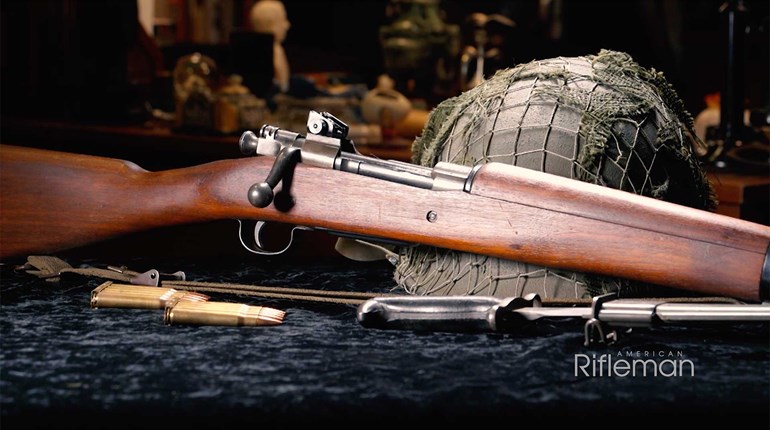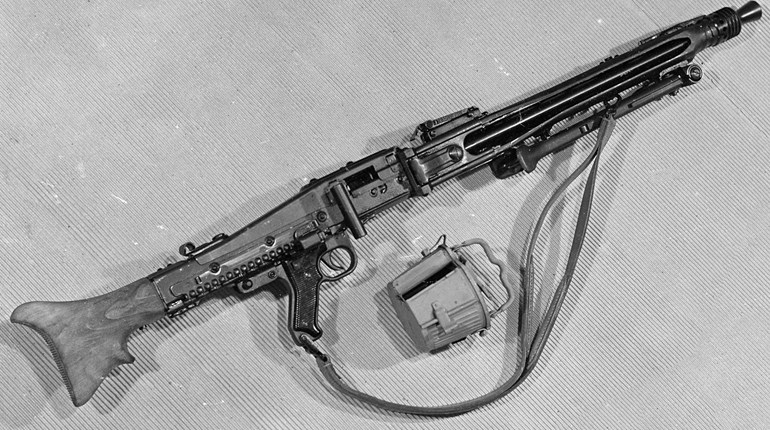
Above: Like several variants of the C96 "broomhandle" Mauser, the Mauser M712 Schnellfeuer included a shoulder stock that also doubled as a holster.
There is a popular image of the Third Reich that calls attention to a short list of the firearms that armed its fighting forces during the Second World War. This image typically includes the Kar98k, the MG.34, the MG.42 and the MP.38 submachine gun—forerunner of the much-admired MP.40. While Germany would fight World War II with more firearms than just those examples, the popularized line-up just does not explore the diversity of guns that served in supplementary roles.
But predecessors inspired each of these well-known designs and in some cases, predecessors were the offspring of necessity. Germany’s development of a practical submachine gun during the interwar period is the perfect example of this, and that process lead to the creation of a gun that does not typically come to mind when we think of the Third Reich: the Mauser M712 Schnellfeuer.

The Versailles Treaty placed significant restrictions on the German military that survived beyond 1919. First of all, the treaty limited it to a mere 100,000 men and then also placed restrictions on the quantity of weapons arming it and the manufacturing capacity that could be used to make more. Only 792 heavy machine guns and 1,134 light machine guns would be permitted. Everything else had to be surrendered to allied forces. But, the treaty did not include provisions limiting either pistols or the newest category of military small arms: the pistol-caliber submachine gun.
With that being the case, German gunmakers were free to continue developing and producing those firearms. Before the Great War, Germany had been a leading arms supplier to the world, and in the aftermath of the conflict other nations recognized a chance to make money and quickly crowded-in to take up the slack. Some of them even began copying German designs.
In 1927, Spanish gunmakers started producing the popular C96 Mauser semi-automatic pistol to meet growing demand for the gun. Chinese warlords wanted the C96 to arm their forces—first Beistegui Hermanos, and then Astra the following year were meeting that need. But, these Spanish broomhandles differ from those made by Mauser in one critical area.

Where the German C96 fires only in semi-automatic mode, the Spanish manufacturers had selective-fire copies available. Not to be outdone by its competitors, Mauser began work on a full-automatic conversion in 1930. An Austrian engineer named Joseph Nickl patented the first version in 1931, and 1,000 examples shipped to China before the end of that year.
But, reliability issues troubled the Nickl design and its production concluded after only approximately 4,000 were made. The following year, another Mauser engineer named Karl Westinger refined the design by simplifying the automatic sear and modifying the selector switch. That second pattern went into production in 1932 and would remain in production through 1938.
Referred to as Schnellfeuer (“rapid fire”), this pistol closely resembles the standard semi-automatic C96 pistol in 7.63x25 mm/.30 Mauser with a 5.5-inch barrel, a rear-sight assembly graduated from 50 to 1,000 meters and a detachable wooden buttstock/holster. However, there are two conspicuous features that visually differentiate the Schnellfeuer from the standard C96: a detachable-box magazine and a fire selector on the left side of the frame with markings for Einzelfeuer (“single fire”) and Reihenfeuer (“series fire”). In full-auto, the pistol produces a cyclic rate of about 900 rounds-per-minute, which makes it near-uncontrollable when not being fired with the buttstock in place. With the buttstock, though, the Schnellfeuer is controllable and presents a practical automatic gun for close-range use.

In the end, Mauser out-produced its Spanish rivals by a significant margin. Almost 100,000 Westinger-pattern Schnellfeuer selective-fire pistols were completed before the end of production in 1938, with the majority being shipped to China where they were well-received. Simultaneous to the production history of the Schnellfeuer was the National Socialist rise to power in German domestic politics. Adolf Hitler became Chancellor in 1933 as mass production of the second pattern of the gun was getting underway.
By the time Hitler consolidated his control over Germany in 1934, Mauser had surpassed production of Astra’s Model 900. In 1939 the German military began purchasing the Schnellfeuer and issuing it to certain combat units, but it didn’t take long for the new MP.38 submachine gun to take center stage. Although it was only on a limited basis, the Mauser Schnellfeuer armed the fighting forces of Nazi Germany during the Second World War and the keen-eyed student of small arms will notice them on occasion in archival photographs.




































